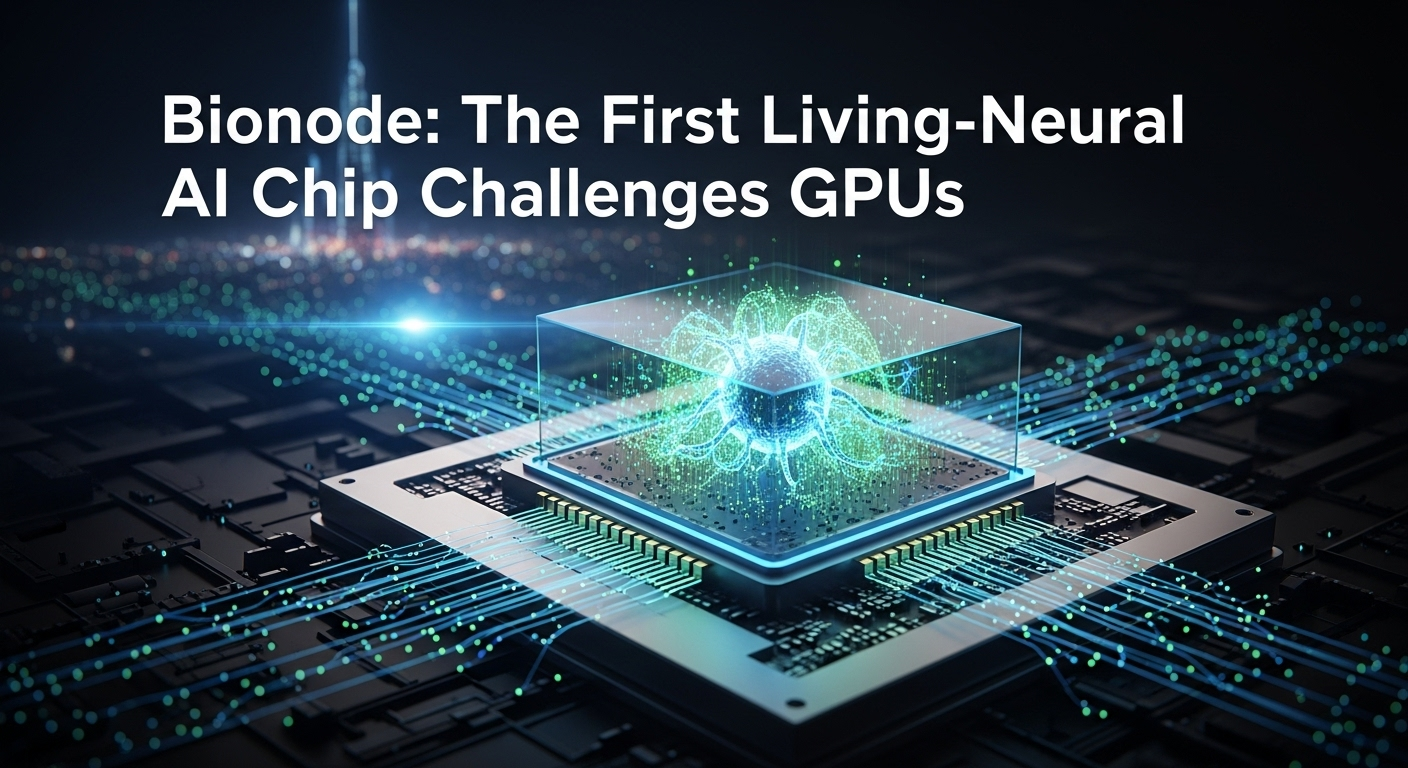Introducing Bionode: The First Living‑Neural AI Chip Challenging Traditional GPUs
The Rise and Limits of Silicon GPUs
For more than a decade, GPUs (Graphics Processing Units)—particularly from Nvidia and AMD—have been the backbone of training and deploying advanced AI systems, powering everything from large language models (LLMs) to autonomous vehicles. In 2023, Nvidia’s data center revenue surged to over US $47 billion, driven by the explosive demand for AI hardware. Yet this power comes at a hefty price: GPUs consume tremendous energy, generate heat, and often require costly retraining as AI models evolve. Training a single 176‑billion‑parameter LLM like Bloom can emit nearly 50 metric tons of CO₂, equivalent to the lifetime emissions of several cars VentureBeat. However, new innovations like the Bionode AI chip are emerging, promising more energy-efficient and adaptable alternatives to the traditional GPU approach.</p>
As AI complexity grows, silicon‑based architectures are increasingly strained. They lack the intrinsic adaptability needed for real‑time learning, making them inefficient for emerging use cases across industries.
What Is Bionode AI Chip and How Does It Work?
Biological Black Box and the Bionode Platform
Biological Black Box (BBB)—a Baltimore‑based startup founded in 2022 by Alexander Ksendzovsky and Jonathan Pomeraniec—has unveiled Bionode, a pioneering AI processor built from lab‑grown living neurons banyan-vc.com. These neurons come from both human stem cells and rat‑derived cells, and are cultured on a microelectrode array featuring 4,096 electrodes, forming a functional, living “chip” network of hundreds of thousands of neurons. independentxpress.de+9VentureBeat+9Due+9.</p>
Hybrid Bio‑Digital Communication
Bionode enables real‑time two‑way interaction with conventional systems:
-
Input Encoding: Digital stimuli (e.g. images or text) are translated into electrical signals.
-
Neuronal Processing: Neurons adapt and rewire dynamically, performing parallel computation on the inputs.
-
Output Decoding: The electrode array captures neural responses and converts them back into digital data.
This process dramatically reduces the need for retraining, offering continuous learning and stability over extended periods (neurons survive in the setup for over a year). independentxpress.de+14This Week In AI+14banyan-vc.com+14Due.</p>
Applications of the Bionode AI Chip in Vision and Language Models
Efficient Computer Vision Pre‑Processing
Unlike traditional GPUs, the Bionode AI chip offers continuous learning without retraining, saving time and energy. In internal tests, Bionode has served as a biological pre‑processing layer in vision workflows—filtering and refining image data before GPU inference. This setup delivered lower latency, reduced GPU energy consumption, and in some scenarios even improved classification accuracy ainave.com+6VentureBeat+6Tei+6.
Energy‑Saving LLM Fine‑Tuning
The Bionode AI chip significantly reduces the computational load for vision AI and LLM tasks, offering a boost in performance with reduced energy consumption. Large language model training has traditionally been energy-intensive. Bionode offers a continuously learning layer that adapts on the fly, reducing the cost and time required for fine‑tuning and incremental updates—without retraining underlying silicon models from scratch XLM Stellar.</p>
Why Major Players Like NVIDIA Are Watching
Strategic Alignment, Not Competition
BBB is part of NVIDIA’s Inception program, an incubator for startups with cutting‑edge AI solutions. Rather than aiming to replace GPUs, BBB positions the Bionode AI chip as a complementary co‑processor—enhancing energy efficiency and adaptability while leveraging existing GPU infrastructure. aibrew.news+7VentureBeat+7Due+7.</p&gt;
>CEO Ksendzovsky emphasizes a long‑term vision where modular ecosystems of silicon, biological, and eventually quantum processors coexist—each optimized for specific workloads and strengths tracxn.com+7banyan-vc.com+7Tei+7.</p>
>BBB is currently in talks with enterprise partners in computer vision and LLM optimization, holding letters of intent from Fortune‑500 companies—even though specific clients remain undisclosed banyan-vc.com</a></a></span>. The company is also relocating to California’s Bay Area to scale operations and tap into the biotech and AI hub.
Implications: A Leap Toward Sustainable, Adaptive AI
Productivity with Purpose
The Bionode AI chip promises three key advantages over conventional AI hardware:
-
Real‑time continuous learning via self‑rewiring neural networks
-
Ultra‑low energy consumption by harnessing biological efficiency near theoretical limits Due+6banyan-vc.com+6Tei+6techspot.com
-
Fast deployment without retraining, ideal for dynamic environments
>This approach aligns with broader efforts in neuromorphic and bio‑computing, where companies like Intel and IBM simulate neural behavior (e.g., Loihi, TrueNorth), but BBB takes a bold step further by deploying actual living neurons as computing elements Duearxiv.org</span>.</p>
Ethical and Technical Considerations
BBB clarifies that Bionode is not a conscious brain or general intelligence. The neurons are organized into task-specific micro‑networks, not generalized cognitive systems. They handle discrete inputs (images, text) and produce outputs like classification results—not sentient thought DueVentureBeat.
Still, using living tissue raises ethical questions: What boundaries exist for lab‑grown neural systems? How should governance adapt? BBB is collaborating with ethicists and regulatory bodies to ensure responsible development and clear ethical safeguards.
Conclusion: The Dawn of Hybrid Biological AI
The Bionode AI chip signals a paradigm shift in AI hardware design. By integrating living neurons into computational systems, Biological Black Box is challenging long-held assumptions about what an AI chip can be. Their architecture offers sustainable adaptability, continuous learning, and significantly lower energy use. While commercial deployment is still in early stages, the implications for healthcare, robotics, edge AI, and sustainable data centers</strong> are profound.</p>
